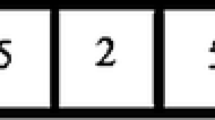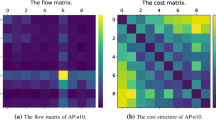Abstract
This study addresses a many-to-many hub location-routing problem where the best-found locations of hubs and the best-found tours for each hub are determined with simultaneous pickup and delivery within the hard time window. To find practical solutions, the hubs and transportation fleet have constrained capacity, in which every node can be serviced by multiple allocations with the hard time window and limited tour length. First, a bi-objective optimization model is proposed to balance travel costs among different routes and to minimize the total sum of fixed costs of locating hubs, the costs of handling, traveling, assigning, and transportation costs. The problem is then solved using an augmented ε-constraint technique for small to medium size instances of the problem. Due to the NP-hardness nature of the problem, the proposed multi-objective optimization model is solved by a multi-objective imperialist competitive algorithm (MOICA). To show the superior performance of the MOICA, the solutions are compared with those obtained by the non-dominated sorting genetic algorithm (NSGA-II). For the large-scale problem instances, the comparative results indicate that the MOICA can indeed provide better Pareto optimal solutions compared to NSGA-II for the large-scale problem instances.




















Similar content being viewed by others
References
Amin-Naseri MR, Yazdekhasti A, Salmasnia A (2018) Robust bi-objective optimization of uncapacitated single allocation p-hub median problem using a hybrid heuristic algorithm. Neural Comput Appl 29:511–532
Atashpaz-Gargari E, Lucas C (2007) Imperialist competitive algorithm: an algorithm for optimization inspired by imperialistic competition. In: IEEE congress on evolutionary computation, 2007. CEC 2007. IEEE, pp 4661–4667
Baños R, Ortega J, Gil C, Márquez AL, De Toro FJC, Engineering I (2013) A hybrid meta-heuristic for multi-objective vehicle routing problems with time windows. Comput Ind Eng 65:286–296
Bashiri M, Rezanezhad M, Tavakkoli-Moghaddam R, Hasanzadeh HJAMM (2018) Mathematical modeling for a p-mobile hub location problem in a dynamic environment by a genetic algorithm. Appl Math Model 54:151–169
Bérubé J-F, Gendreau M, Potvin J-Y (2009) An exact ϵ-constraint method for bi-objective combinatorial optimization problems: application to the Traveling Salesman Problem with Profits. Eur J Oper Res 194:39–50
Bostel N, Dejax P, Zhang M (2015) A model and a metaheuristic method for the Hub location routing problem and application to postal services. In: 2015 international conference on industrial engineering and systems management (IESM), IEEE, pp 1383–1389
Boukani FH, Moghaddam BF, Pishvaee MSJ (2016) Robust optimization approach to capacitated single and multiple allocation hub location problems. Comput Appl Math 35:45–60
Campbell JF (1994) Integer programming formulations of discrete hub location problems. Eur J Oper Res 72:387–405
Censor Y (1977) Pareto optimality in multiobjective problems. Appl Math Optim 4:41–59
Çetiner S, Sepil C, Süral HJ (2010) Hubbing and routing in postal delivery systems. Ann Oper Res 181:109–124
Cohon JL (2004) Multiobjective programming and planning. Courier Corporation, Chelmsford
de Camargo RS, de Miranda G, Løkketangen AJAMM (2013) A new formulation and an exact approach for the many-to-many hub location-routing problem. Appl Math Model 37:7465–7480
Deb K, Agrawal S, Pratap A, Meyarivan T (2000) A fast elitist non-dominated sorting genetic algorithm for multi-objective optimization: NSGA-II. In: International conference on parallel problem solving from nature. Springer, pp 849–858
Duhamel C, Lacomme P, Prins C, Prodhon C (2010) A GRASP × ELS approach for the capacitated location-routing problem. Comput Oper Res 37:1912–1923
Dukkanci O, Kara BY (2017) Routing and scheduling decisions in the hierarchical hub location problem. Comput Oper Res 85:45–57
Enayatifar R, Yousefi M, Abdullah AH, Darus AN (2013) MOICA: a novel multi-objective approach based on imperialist competitive algorithm. Appl Math Comput 219(17):8829–8841
Esmaeili M, Sedehzade S (2018) Designing a hub location and pricing network in a competitive environment. J Ind Manag Optim 13(5):1271–1295
Feili H, Ahmadian P, Rabiei E, Karimi J, Majidi B (2015) Ranking of suitable renewable energy location using AHP method and scoring systems with sustainable development perspective. In: 6th International conference on economics, management, engineering science and art. Brussels, Belgium
Gelareh S, Monemi RN, Nickel SJ (2015) Multi-period hub location problems in transportation. Transp Res Part E Logist Transp Rev 75:67–94
Ghaffarinasab N, Van Woensel T, Minner S (2018) A continuous approximation approach to the planar hub location-routing problem: modeling and solution algorithms. Comput Oper Res 100:140–154
Ghezavati V, Hosseinifar P (2018) Application of efficient metaheuristics to solve a new bi-objective optimization model for hub facility location problem considering value at risk criterion. Soft Comput 22:195–212
Govindan K, Jafarian A, Khodaverdi R, Devika KJ (2014) Two-echelon multiple-vehicle location–routing problem with time windows for optimization of sustainable supply chain network of perishable food. Int J Prod Econ 152:9–28
Hamacher HW, Nickel SJLS (1998) Classification of location models. Locat Sci 6:229–242
Hassannayebi E, Boroun M, Jordehi SA, Kor H (2019) Train schedule optimization in a high-speed railway system using a hybrid simulation and meta-model approach. Comput Ind Eng 138:106110
Hassannayebi E, Memarpour M, Mardani S, Shakibayifar M, Bakhshayeshi I, Espahbod S (2019) A hybrid simulation model of passenger emergency evacuation under disruption scenarios: a case study of a large transfer railway station. J Simul. https://doi.org/10.1080/17477778.2019.1664267
Hassannayebi E, Zegordi SH, Amin-Naseri MR, Yaghini MJ (2017) Train timetabling at rapid rail transit lines: a robust multi-objective stochastic programming approach. Oper Res Int J 17:435–477
Ishfaq R, Sox CRJ (2011) Hub location–allocation in intermodal logistic networks. Eur J Oper Res 210:213–230
Karimi H, Setak M (2018) A bi-objective incomplete hub location-routing problem with flow shipment scheduling. Appl Math Model 57:406–431
Karimi H (2018) The capacitated hub covering location-routing problem for simultaneous pickup and delivery systems. Comput Ind Eng 116:47–58
Kartal Z, Hasgul S, Ernst A (2017) Single allocation p-hub median location and routing problem with simultaneous pick-up and delivery. Transp Res Part E Logist Transp Rev 108:141–159
Khosravi S, Jokar M (2018) Many to many hub and spoke location routing problem based on the gravity rule. Uncertain Supp Chain Manag 6:393–406
Kim H, O’Kelly M (2009) Reliable p-hub location problems in telecommunication networks. Geogr Anal 41:283–306
Lin C-C, Lee S-C (2018) Hub network design problem with profit optimization for time-definite LTL freight transportation. Transp Res Part E Logist Transp Rev 114:104–120
Lopes MC, de Andrade CE, de Queiroz TA, Resende MG, Miyazawa F (2016) Heuristics for a hub location-routing problem. Networks 68:54–90
Mavrotas G, Florios K (2013) An improved version of the augmented ε-constraint method (AUGMECON2) for finding the exact pareto set in multi-objective integer programming problems. Appl Math Comput 219:9652–9669
Mavrotas G (2009) Effective implementation of the ε-constraint method in multi-objective mathematical programming problems. Appl Math Comput 213:455–465
Meier JF (2017) An improved mixed integer program for single allocation hub location problems with stepwise cost function. Int Trans Oper Res 24:983–991
Memarpour M, Hassannayebi E, Miab NF, Farjad A (2019) Dynamic allocation of promotional budgets based on maximizing customer equity. Oper Res Int J. https://doi.org/10.1007/s12351-019-00510-3
Mogale D, Kumar SK, Márquez FPG, Tiwari MKJC, Engineering I (2017) Bulk wheat transportation and storage problem of public distribution system. Comput Ind Eng 104:80–97
Mohammadi M, Jolai F, Rostami HJM, Modelling C (2011) An M/M/c queue model for hub covering location problem. Math Comput Model 54:2623–2638
Mohammed MA, Ghani MKA, Hamed RI, Mostafa SA, Ahmad MS, Ibrahim DA (2017) Solving vehicle routing problem by using improved genetic algorithm for optimal solution. J Comput Sci 21:255–262
Mokhtari N, Abbasi M (2015) Applying VNPSO algorithm to solve the many-to-many hub location-routing problem in a large scale. Eur Online J Nat Soc Sci Proc 3:647–656
Moraga R, Rabiei Hosseinabad E (2017) A system dynamics approach in air pollution mitigation of metropolitan areas with sustainable development perspective: a case study of Mexico City. J Appl Environ Biol Sci 7:164–174
Nagy G, Salhi S (2007) Location-routing: issues, models and methods. Eur J Oper Res 177:649–672
Nagy G, Salhi S (1998) The many-to-many location-routing problem. Top 6:261–275
Newbery DM, Stiglitz J (1984) Pareto inferior trade. Rev Econ Stud 51:1–12
Nikbakhsh E, Zegordi S (2010) A heuristic algorithm and a lower bound for the two-echelon location-routing problem with soft time window constraints. Sci Iran Trans E Ind Eng 17:36
Qu B, Weng K (2009) Path relinking approach for multiple allocation hub maximal covering problem. Comput Math Appl 57:1890–1894
Rieck J, Ehrenberg C, Zimmermann J (2014) Many-to-many location-routing with inter-hub transport and multi-commodity pickup-and-delivery. Eur J Oper Res 236:863–878
Sajedinejad A, Chaharsooghi SK (2018) Multi-criteria supplier selection decisions in supply chain networks: a multi-objective optimization approach. Ind Eng Manag Syst 17:392–406
Song B, Zhuo FJSE (2003) An improved genetic algorithm for vehicle routing problem with soft time windows. Syst Eng 6:12–15
Tomoiagă B, Chindriş M, Sumper A, Sudria-Andreu A, Villafafila-Robles R (2013) Pareto optimal reconfiguration of power distribution systems using a genetic algorithm based on NSGA-II. Energies 6:1439–1455
Tong L, Nie L, Guo G-C, Leng N-N, Xu R-X (2018) Layout scheme of high-speed railway transfer hubs: bi-level modeling and hybrid genetic algorithm approach. Clust Comput 22(Suppl 5):12551
Wasner M, Zäpfel G (2004) An integrated multi-depot hub-location vehicle routing model for network planning of parcel service. Int J Prod Econ 90:403–419
Winsper M, Chli M (2013) Decentralized supply chain formation using max-sum loopy belief propagation. Comput Intell 29:281–309
Xu X, Zheng Y, Yu L (2018) A bi-level optimization model of LRP in collaborative logistics network considered backhaul no-load cost. Soft Comput 22:5385–5393
Yang T-H, Chiu T-YJJOI (2016) Airline hub-and-spoke system design under stochastic demand and hub congestion. J Ind Prod Eng 33:69–76
Yetgin H, Cheung KTK, Hanzo L (2012) Multi-objective routing optimization using evolutionary algorithms. In: IEEE, pp 3030–3034
Zade AE, Sadegheih A, Lotfi MM (2014) A modified NSGA-II solution for a new multi-objective hub maximal covering problem under uncertain shipments. J Ind Eng Int 10:185–197
Zarandi MHF, Hemmati A, Davari S, Turksen IB (2013) Capacitated location-routing problem with time windows under uncertainty. Knowl-Based Syst 37:480–489
Author information
Authors and Affiliations
Corresponding author
Ethics declarations
Conflict of interest
The authors reported no potential conflict of interest.
Additional information
Publisher's Note
Springer Nature remains neutral with regard to jurisdictional claims in published maps and institutional affiliations.
Rights and permissions
About this article
Cite this article
Basirati, M., Akbari Jokar, M.R. & Hassannayebi, E. Bi-objective optimization approaches to many-to-many hub location routing with distance balancing and hard time window. Neural Comput & Applic 32, 13267–13288 (2020). https://doi.org/10.1007/s00521-019-04666-z
Received:
Accepted:
Published:
Issue Date:
DOI: https://doi.org/10.1007/s00521-019-04666-z




